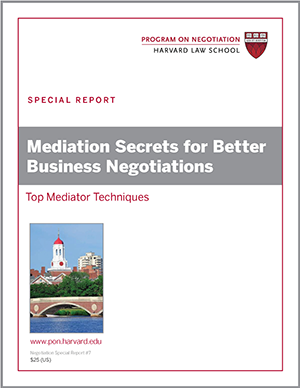
If you manage people, disputes will show up at your door. Take the following example in which mediation techniques helped resolve an intractable dispute: The marketing VP protests that the budget cap you and your new finance VP proposed is hindering a research initiative you supported.
How to Resolve Disputes Between Employees Using Mediation
Or also consider these scenarios: Two young sales representatives are embroiled in a turf war.
Your administrative assistant is upset because the HR director won’t approve the extra week of paid maternity leave you promised her.
Fail to address such employee concerns and you’ve failed as a leader. But it can be difficult to know how to respond, especially when you have a stake in the problem. Sometimes third-party intervention can make matters worse. In recent years, managers have begun to adopt the proven skills of professional mediators and arbitrators in the form of employee mediation techniques to resolve and manage workplace conflict.
Employee Mediation Techniques for Conflict Management
In his book Leading Leaders: How to Manage Smart, Talented, Rich, and Powerful People (Amacom, 2006), Tufts University professor Jeswald Salacuse shows how alternative dispute-resolution techniques can defuse tensions and get everyone back to work. Using mediation skills as a leader Rather than imposing a decision, a trained mediator applies communication skills, objectivity, and creativity to help disputants reach their own voluntary solution to the conflict. As a leader, your role can be more complicated. Unlike an actual mediator, you’ll have to live with the outcome of the dispute on a daily basis. Your personal allegiances and objectives may lead you to have strong opinions about the best result. In addition, the negotiated agreement must satisfy the interests of the broader organization as well as those of the disputants. For these reasons, leaders need to adapt mediation skills to their purposes. As long as the disputants respect your authority, you should feel empowered to try to change the behavior of one or both sides to serve the organization’s best interests, writes Salacuse.
He has identified six bases of social power that will give you the leverage you need.
1. Rewards.
As a leader, you have access to resources you can use to reward disputants for changing their behavior. Suppose you have been so impressed by your marketing VP’s achievements that you’re committed to funding the research initiative despite the budget cap that your finance VP wants to enforce. As CEO, you may be able to tap special funds for the project without requiring an exception to the rule. Anticipate, however, that some in your organization may view such special arrangements and rewards as a sign of weakness or as a bad precedent.
2. Coercion.
Leaders can punish as well as reward, notes Salacuse. If you are tired of your sales reps’ constant bickering over who poached whose client, you could threaten to take away key accounts from both if they can’t work out a solution. But be careful not to be too heavy-handed with coercion tactics, lest you drive the conflict deeper and closer to home.
3. Expertise.
Often, subordinates bring their disputes to their bosses because they expect them to apply specialized expertise to a problem. Your managerial smarts should convince your finance VP to accept your support of the marketing VP’s new initiative. Lawyers, doctors, and other professionals bring unique knowledge and skills to the conflicts in their offices. Salacuse warns, however, that disputants may be dismissive of your recommendations if they perceive your expertise to be no greater than theirs.
4. Legitimacy.
A leader’s legitimacy varies by organization and by the nature of the dispute. In a top-down organization, employees will be more likely to accept the guidance of an authority figure than employees of a less-hierarchical firm will be. If your HR director is used to having a great deal of autonomy, he may fight back if you lobby for your assistant to receive an extra week’s maternity leave.
5. Relationships.
The degree to which you can influence a disputant also depends on the nature and strength of your relationship with that person. Suppose you decide that you erred in offering your assistant a longer maternity leave than other employees. You should have a better chance of persuading her to accept this view if she has worked closely with you for 10 years than if she only joined the organization a year ago. The desire to preserve the relationship can be sufficient motivation for a disputant to follow your advice.
6. Coalitions and networks.
Sometimes outside help is required to effectively resolve a dispute. By building coalitions and capitalizing on existing social networks, you can gain support for your proposal, Salacuse writes. For instance, if you are relatively new to your organization, you might ask a senior partner who has worked closely with at least one of the two warring sales reps to help you resolve the conflict.
Which mediation techniques have helped you solve a conflict? Tell us in the comments.
Adapted from “Resolve Employee Conflicts Through Mediation Techniques,” first published in the December 2007 issue of Negotiation.





Workplace Mediation has its unique characteristics and require the use of the appropriate Mediation Model. The conflict resolution principles and processes provided by the Insight Mediation model and Solution Focused Mediation model have parties looking forward and positively and keep focus away from past problems . Next an understanding of the organization is important.. Most organizations have a Strategic Plan consisting of a Mission Statement, Goals,, Values and Action Plans. For a workplace mediator these are the starting points in preparation for the mediation as these documents provide the framework in which the conflicting parties co-exist. Next the mediator holds a trust building session with each employee separately and in which the mediator listens to the parties’ concerns. This session is also a bit of educational session for the participant as the mediator discusses some of the principles and processes of the selected Mediation models. This session concludes with the mediator asking the party to describe in three (3) words their desired working relationship with the other party. NOTE: Often times the three words are some of the same or similar words in the Organization strategic documents.
The Joint session with the parties requires little introduction due to the foundation laid in the single party sessions.. The Joint Session begins with the mediator seeking the parties OK to scribe on the Flip Chart or blackboard the three (3) words that were chosen to describe their future relationship. The mediator then scribes the words for the parties to see.. Without fail there will be overlap with what each party wants in their relationship. Respect is the word used in virtually all of these sessions. The mediator then asks the parties which word they would like to select as the basis for their discussion. For example if ‘respect’ is chosen the Mediator then asks ‘what does respect look like in everyday dealings with one another? The mediation continues using the rest of the words. As the parties discuss their words the Mediator scribes on the flip chart the key elements of their discussion and this will form the road map for the parties going forward..
When that process concludes the mediator then asks ‘What happens when your relationship falls on the rocks again notwithstanding all you have developed here? This is the mediators direction to them to develop a process to handle their conflict in future. For example this could include an agreement that when things fall apart they will revisit their mediation notes and their three (3) chosen words..
The mediation wraps with a decision by the parties who wil get the notes typed up. Success!
The scale of Negotiations greatly varies depending on the complexity of the situation. Negotiation and conflict management are largely used in International relations due to the large benefits and advantages it has as compared to other methods. Negotiations at International levels lead to management of conflicts, cessation of violence and open newer ways of interactions
I was a manager in the corporate world for 6 years and was very surprised that I never had to resolve any sort of conflict between the employees that I oversaw. I did witness conflict though in the workplace, and it wasn’t always handled well. Great post on resolving conflict, thanks for sharing!